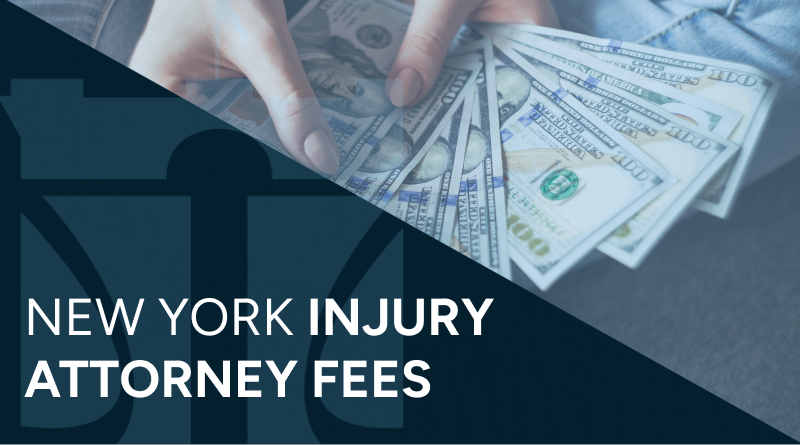Here in New York, the personal injury lawyer fees are almost always one-third (1/3) of the sum recovered, or 33.33%*.
A recent change in New York personal injury law has created two separate options for how the 1/3 contingency fee is calculated, both of which we will go over, but the important thing to remember is that the personal injury attorney’s fee will be 1/3 (33.33%) regardless of which option you choose. This will always be consistent.
*The exception to the 1/3 fee is in a medical malpractice case where there is a sliding scale, which is not covered here.
Personal Injury in New York? Reach Out to Ferrante & Koenig 24/7 for a Free Consult.
New York Personal Injury Lawyers Work on a Contingency Fee Basis

Generally, New York personal injury lawyers work on a contingency basis. This means that your personal injury lawyer does not earn a fee until the case has been resolved and there was a positive monetary recovery.
This is the case whether you were involved in a car accident in Brooklyn or a trip and fall in the Bronx.
In other words, for an injury lawyer to get paid, you will be walking away from the case with money via settlement or verdict.
Payment Option 1: Percentage of Net Recovery
Under the first option, the case expenses are taken off of the top, meaning they are subtracted from the full personal injury settlement amount. The 1/3 contingency fee is taken from what remains. This option can also be described as 1/3 of the net recovery or 1/3 of the profit of the case.
In this scenario, the client retains some risk because if the case is not successful, the attorney will have the right to charge the client for the expenses, which are usually paid out of pocket by the attorney. So, if the case is lost, then the attorney has the right to send a bill for whatever money was spent to move the case forward.
In reality, this “risk” is not a very significant one as (1) the vast majority of accepted cases are settled; and (2) most firms would never send a bill to a client after they’ve lost their case. That would really be kicking someone while they are down (but the attorney does have the right to do so under this option).
In return for taking this risk, the client will see small savings at the end of the case. The personal injury lawyer fees are calculated after the expenses are taken off of the top, so the accident attorney shares in paying the expenses in this scenario. It amounts to a savings of 1/3 of the expenses, meaning that if the expenses were $1,500.00 for your case, you would get $500.00 more at the end under Option 1.
Payment Option 2: Percentage of Total Recovery
The second option changes the equation a little bit. The 1/3 fee is taken from the total recovery instead of the net recovery. The injury attorney’s fee is 1/3 of the full settlement amount. The client is responsible for repaying the attorney for the case expenses from the remainder.
Under this option, there is no risk that the client will receive a bill for the case expenses if you lose.
The trade-off is that the client will see a little bit less money if you win. Here, as the expenses are paid out of your portion of the settlement proceeds the attorney doesn’t share in the ultimate cost. So you are losing out on the 1/3 contribution towards expenses that you would get under Option 1. As described above, if the expenses in your case were $1,500.00, you would see $500.00 less under Option 2.
What Types of Expenses Can I Expect?
When pursuing a personal injury claim, it’s important to understand the various costs that may arise beyond attorney fees. These additional expenses can impact the overall financial commitment required for your case.
Expert Witness Fees
Expert witnesses can play a crucial role in strengthening your case by providing professional testimony to support your claims. However, their services come at a cost, and fees can vary depending on the complexity of the case. If expert testimony is necessary, your personal injury attorney in New York will discuss potential expenses and how they might impact your case.
Court Filing Costs
Initiating a personal injury lawsuit involves court filing fees, which are necessary to process your case through the legal system. While these fees are generally not excessive, they do contribute to the total cost of litigation. A personal injury lawyer in New York should provide a clear breakdown of these expenses so you know what to expect.
Administrative Fees
Legal cases often involve smaller administrative expenses that add up over time. These include document copying, postage, and clerical work necessary for case preparation. While these costs may seem minor individually, they contribute to your overall personal injury attorney fees.
How Are Expenses Covered in New York Personal Injury Cases?
The personal injury lawyer fees in a case are generally advanced by the lawyer handling the case. To move the case forward, money must be spent to investigate the incident, hire investigators and/or an engineer, gather medical records, file a lawsuit, serve the defendants, pay court filing fees, take depositions, create demonstrative evidence and prepare the case for trial. All of these expenses must be ultimately repaid at the conclusion of the case.
It is essentially a zero-interest loan.
The average expenses in a personal injury case vary depending on the type of case and how far it was pushed. Obviously, the personal injury attorney fees on a simple car accident case that was settled within 6 months will be much less than the expenses on a complex construction site accident case that has been fully litigated for 4 years.
Examples of NY Personal Injury Lawyer Fees
Client A was involved in a rear-end car accident. She suffered a herniated disc in her neck and a torn meniscus in her knee. The insurance company did not agree that her injuries were serious under New York law and offered no money. A lawsuit was started against the owner and driver of the vehicle, the defendants were served, and the case was litigated through depositions. After pushing the case close to trial, a reasonable settlement offer was made and accepted. The expenses in this case may range between approximately $1,000.00 – $1,500.00.
Client B was caused to trip and fall over a raised sidewalk in Manhattan. She fractured or broke her wrist and required an open reduction internal fixation (ORIF) surgery. An engineer was hired to investigate the accident location and offer an opinion on the dangerous sidewalk. The case was litigated against the owner of the building, the management company, the ground floor tenant, and a contractor who previously performed work in that area. A lawsuit was started, the defendants were served, depositions of all of these parties were held, and then the case was settled at mediation. The expenses in this case may range between $3,500.00 – $5,000.00.
These are only examples, and every case is completely different.



















